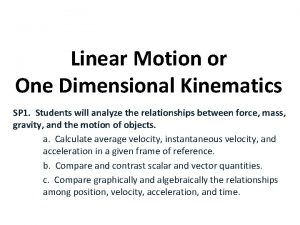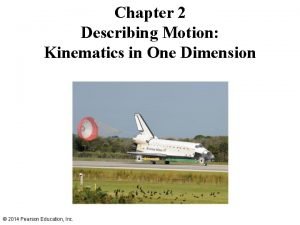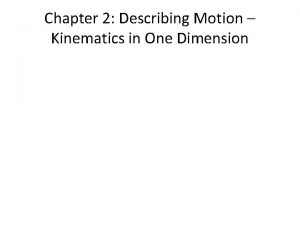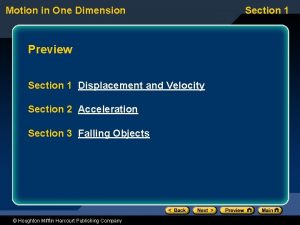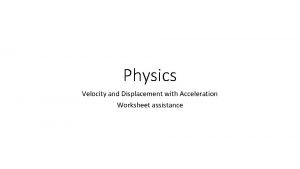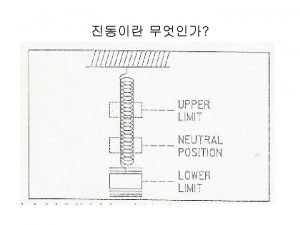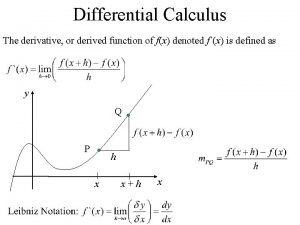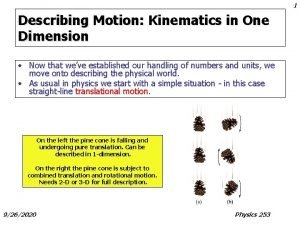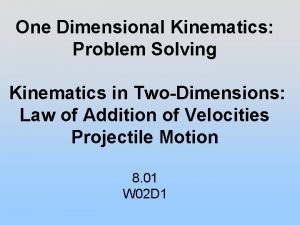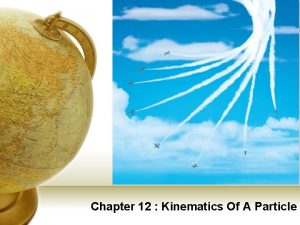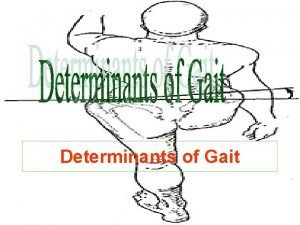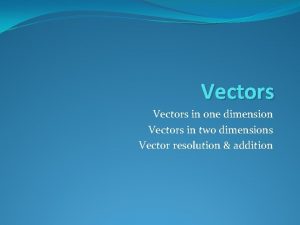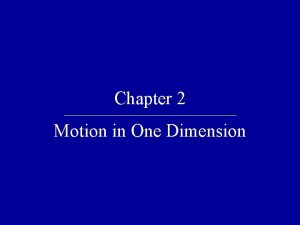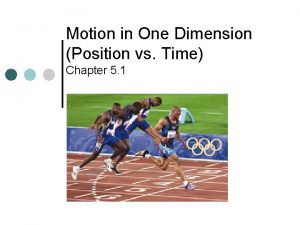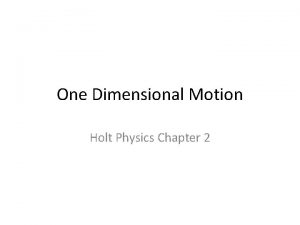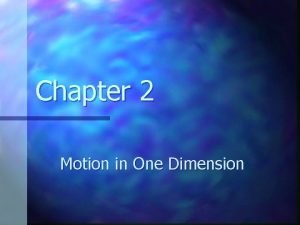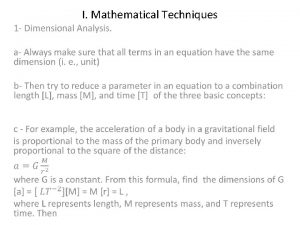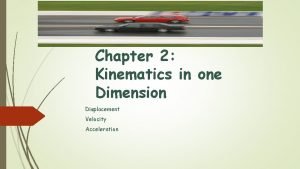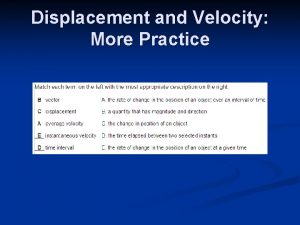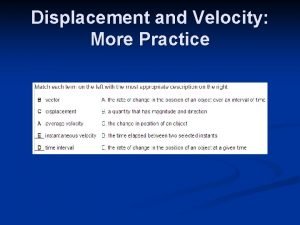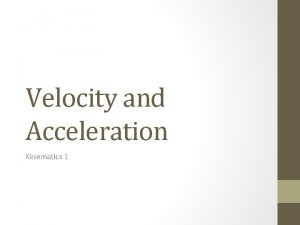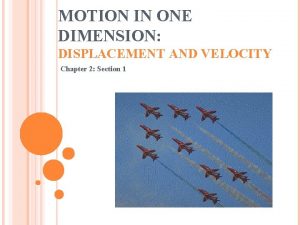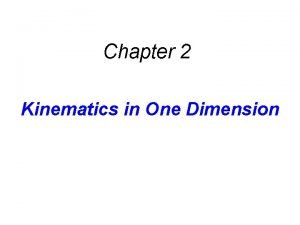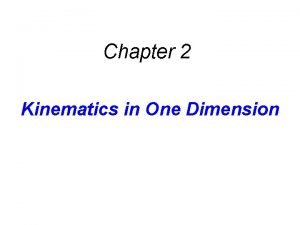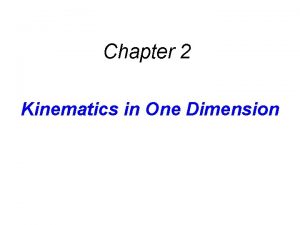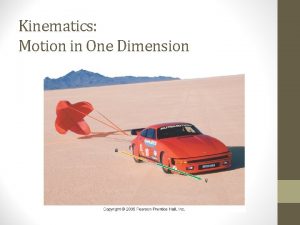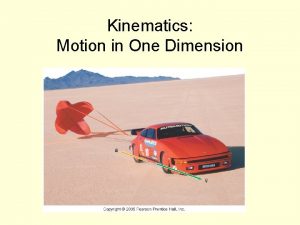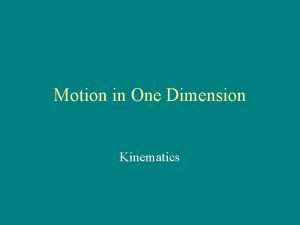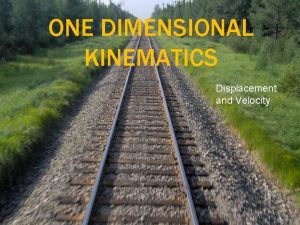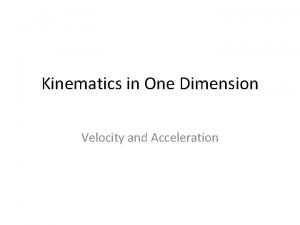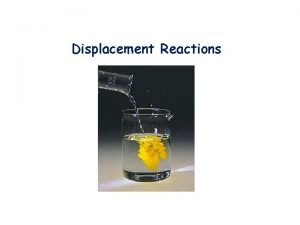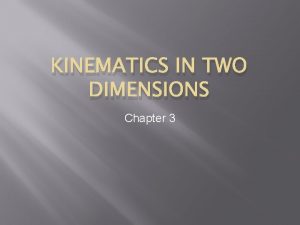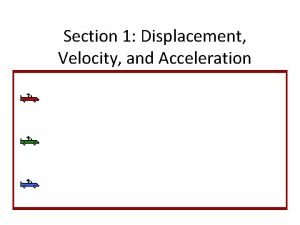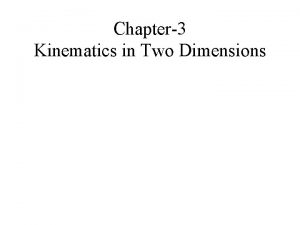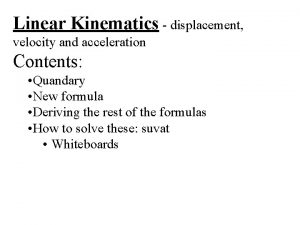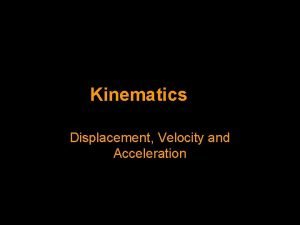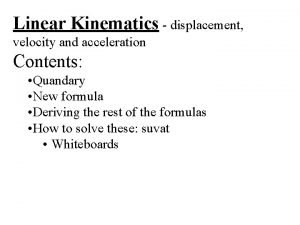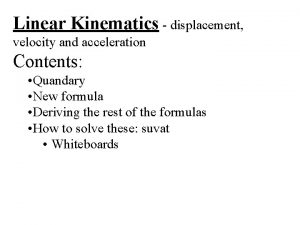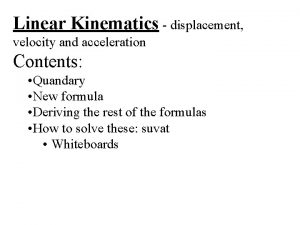Chapter 2 Kinematics in one Dimension Displacement Velocity









































- Slides: 41

Chapter 2: Kinematics in one Dimension Displacement Velocity Acceleration

Multiplying Significant Figures • Distance = velocity x time Velocity = 65. 4 mph Time = 4. 2 hours • Distance=274. 7 or 275 or 2. 7 x 102 miles • When you multiply (or divide) you keep the number of significant figures that are equal to the quantity with the smallest number of significant figures.

Importance of Units • The 165 million dollars Mars Polar Lander • Units help you figure out equations Speed in mph Density in kg/m 3 • Units help you determine the correct solution www. nasa. gov

Units, Standards, and the SI System Quantity Unit Standard Length Meter Length of the path traveled by light in 1/299, 792, 458 second Time Second Time required for 9, 192, 631, 770 periods of radiation emitted by cesium atoms Mass Kilogram Old def: (until Summer 2019): Platinum cylinder in International Bureau of Weights and Measures, in Paris. New def: the international prototype of the kilogram (IPK). Alternatively, in the energy equivalence relations E = hf= mc 2 = e. V = k. T the Planck constant h, the speed of light c, the elementary charge e, and the Boltzmann constant k can also be reference quantities since they are invariants with specific values. https: //www. nist. gov/si-redefinition/meet-constants

Units, Standards, and the SI System

Units, Standards, and the SI System

Units, Standards, and the SI System

Units, Standards, and the SI System We will be working in the SI system, in which the basic units are kilograms, meters, and seconds. Quantities not in the table are derived quantities, expressed in terms of the base units. Other systems: cgs; units are centimeters, grams, and seconds. British engineering system has force instead of mass as one of its basic quantities, which are feet, pounds, and seconds.

Converting units Problem 11. (I) Write the following as full (decimal) numbers with standard units: (a) 286. 6 mm, (b) 35 m. V, (c) 760 mg, (d) 60. 0 ps, (e) 22. 5 fm, (f) 2. 50 gigavolts.

Problem 11 Solutions

Converting units Problem 15. (II) What is the conversion factor between (a) ft 2 and yd 2 (b) m 2 and ft 2 1 yd=3 ft and 1 m=3. 28 ft

Problem 15 Solutions

Converting units Write this in miles/s and miles/hour § 30. 0 km/h =? 1 km = 0. 6214 miles 1 mile=1. 6093 km How many Us dollars is in 220 Canadian dollars? § $220 Canadian Dollars = ? 1 US dollar = 1. 31 Canadian dollar

Converting units

Problem 65 Solutions

Question 1 atm = 1. 013 x 105 Pa = 14. 70 lb/in 2 If you want to convert 0. 46 atm to Pa you should A. Multiply 0. 46 atm by 14. 70 lb/in 2 B. Multiply 0. 46 atm by 1. 013 x 105 Pa C. Divide 0. 46 atm by 14. 70 lb/in 2 D. Divide 0. 46 atm by 1. 013 x 105 Pa

Converting units 1. Multiplying by 1 leaves a quantity unchanged. 2. “ 1” can be represented as 3. Choose form for ‘ 1’ for which units match.

Prefixes q Prefixes correspond to powers of 10 q Each prefix has a specific name q Each prefix has a specific abbreviation

Prefixes § The prefixes can be used with any base units § They are multipliers of the base unit § Examples: v 1 mm = 10 -3 m v 1 mg = 10 -3 g

Fundamental and Derived Quantities • In mechanics, three fundamental or base quantities are used • Length • Mass • Time • Will also use derived quantities • These are other quantities that can be expressed as a mathematical combination of fundamental quantities

Density • Density is an example of a derived quantity • It is defined as mass per unit volume • Units are kg/m 3

Order of Magnitude: Rapid Estimating A quick way to estimate a calculated quantity is to round off all numbers to one significant figure and then calculate. Your result should at least be the right order of magnitude; this can be expressed by rounding it off to the nearest power of 10. Diagrams are also very useful in making estimations.

Order of Magnitude: Rapid Estimating Example 1 -6: Thickness of a page. Estimate thickness of a page of your textbook. (Hint: you don’t need one of these!)

Chapter 2: Kinematics in one Dimension Displacement Velocity Acceleration

Chapter 2: Kinematics in one Dimension Coordinate Axis y -x o -y In Physics we draw a set of coordinate axis to represent a frame of reference. In one dimensional axis coordinate, the position of x an object is given by its x or y.

Position on a line 1. 2. 3. 4. Reference point (origin) position Distance Direction • The position of Charlotte in reference to Fort Mill ( Fort Mill is the origin) • Symbol for position: x • SI units: meters, m

Displacement on a line • Change of position is called Displacement: xf xi Displacement is a vector quantity It has magnitude and direction

Displacement Defined as the change in position during some time interval Represented as x SI units are meters (m) x can be positive or negative Different than distance – the length of a path followed by a particle. Displacement has both a magnitude and a direction so it is a vector.

Example Mary walks 4 meters East, 2 meters South, 4 meters West, and finally 2 meters North. The entire motion lasted for 24 seconds. Determine the displacement and distance Mary travelled.

Vectors and Scalars Vector quantities need both a magnitude (size or numerical value) and direction to completely describe them Will use + and - signs to indicate vector directions Scalars quantities are completely described by magnitude only

Average Speed Average speed =distance traveled/ time elapsed Example: if a car travels 300 kilometer (km) in 2 hours (h), its average speed is 150 km/h. Not to confuse with average velocity. Average speed is a scalar

Average Velocity The average velocity is rate at which the displacement occurs The SI units are m/s Is also the slope of the line in the position – time graph

Average Velocity, cont Gives no details about the motion Gives the result of the motion It can be positive or negative It depends on the sign of the displacement It can be interpreted graphically It will be the slope of the position-time graph

Average Speed and Average Velocity Speed is how far an object travels in a given time interval: Velocity includes directional information:

Not to Confuse Speed is a number : a scalar Velocity is a vector : with a magnitude and a direction

Average velocity Position (x) from a graph of x(t) x 2 v(t) = slope of x(t) x 1 t 1 Time (t) t 2

Average Speed Example 2 -2: Distance a cyclist travels. How far can a cyclist travel in 2. 5 h along a straight road if her average speed is 18 km/h?

Example 1 While on Vacation Lisa traveled a total distance of 440 miles her trip took 8 h , what was her average speed?

Example 1 solution

Example 2 Mary walks 4 meters East, 2 meters South, 4 meters West, and finally 2 meters North. The entire motion lasted for 24 seconds. Determine the average speed and the average velocity.

Mary walked a distance of 12 meters in 24 seconds; thus, her average speed was 0. 50 m/s. However, since her displacement is 0 meters, her average velocity is 0 m/s. Remember that the displacement refers to the change in position and the velocity is based upon this position change. In this case of the Mary’s motion, there is a position change of 0 meters and thus an average velocity of 0 m/s.
 Constant speed tape chart
Constant speed tape chart Describing motion kinematics in one dimension
Describing motion kinematics in one dimension Describing motion kinematics in one dimension
Describing motion kinematics in one dimension Aplusphysics kinematics-horizontal kinematics
Aplusphysics kinematics-horizontal kinematics Jacobian singularity
Jacobian singularity Single displacement vs double displacement
Single displacement vs double displacement Dimension of displacement
Dimension of displacement Displacement and velocity worksheet
Displacement and velocity worksheet Vibration displacement velocity acceleration
Vibration displacement velocity acceleration Is differential and derivative the same
Is differential and derivative the same Forces in one dimension chapter 4
Forces in one dimension chapter 4 Vf=vo
Vf=vo Chapter 4: forces in one dimension answer key
Chapter 4: forces in one dimension answer key Darcy velocity vs seepage velocity
Darcy velocity vs seepage velocity Linear acceleration and angular acceleration
Linear acceleration and angular acceleration Initial velocity and final velocity formula
Initial velocity and final velocity formula Is v final velocity
Is v final velocity Final velocity initial velocity acceleration time
Final velocity initial velocity acceleration time Instantaneous velocity vs average velocity
Instantaneous velocity vs average velocity Darcy's law
Darcy's law Tangential speed
Tangential speed Tangential speed
Tangential speed One dimensional kinematics problems
One dimensional kinematics problems Kinematics of a particle
Kinematics of a particle The lateral displacement of cog exceeds one inch with:
The lateral displacement of cog exceeds one inch with: Vectors in one dimension
Vectors in one dimension Motion in one dimension quiz
Motion in one dimension quiz To describe a position in more than one dimension
To describe a position in more than one dimension In 1935 a french destroyer la terrible attained
In 1935 a french destroyer la terrible attained Free fall motion in one dimension
Free fall motion in one dimension Undefined terms and basic definitions worksheet answers
Undefined terms and basic definitions worksheet answers Time dimension in research sample
Time dimension in research sample Motion in one dimension
Motion in one dimension 2d motion equations
2d motion equations Mathematical techniques
Mathematical techniques One god one empire one emperor
One god one empire one emperor One one one little puppy run
One one one little puppy run One king one law one faith
One king one law one faith One god one empire one emperor
One god one empire one emperor One ford behaviors
One ford behaviors See one do one teach one
See one do one teach one See one, do one, teach one
See one, do one, teach one
